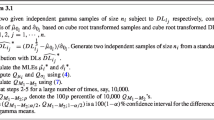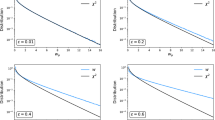Abstract
In this paper we propose two bootstrap goodness of fit tests for the log-gamma distribution with three parameters, location, scale and shape. These tests are built using the properties of this distribution family and are based on the sample correlation coefficient which has the property of invariance with respect to location and scale transformations. Two estimators are proposed for the shape parameter and show that both are asymptotically unbiased and consistent in mean-squared error. The test size and power is estimated by simulation. The power of the two proposed tests against several alternative distributions is compared to that of the Kolmogorov-Smirnov, Anderson-Darling, and chi-square tests. Finally, an application to data from a production process of carbon fibers is presented.



Similar content being viewed by others
References
Cantú SM, Villaseñor AJA, Barry CA (2001) Modeling the lifetime of longitudinal elements. Commun Stat Simul Comput 34(3):717–741
Crooks GE (2007) The Amoroso distribution. Tech. Note 1(3):1–6
DiCiccio TJ (1987) Approximate inference for the generalized gamma distribution. Technometrics 29(1):33–40
Gomes O, Combes C, Dussauchoy A (2008) Parameter estimation of the generalized gamma distribution. Math Comput Simul 79:955–963
Hager HW, Bain JL (1970) Inferential procedures for the generalized gamma distribution. J Am Stat Assoc 65:1601–1609
Harter HL (1967) Maximum likelihood estimation of the parameters of a fourparameter generalized gamma population from complete and censored samples. Technometrics 9:159–165
Kaneko R (2003) Elaborate of the Coale–McNeil nuptiality model as the generalized log gamma distribution: a new identity and empirical enhancements. Demogr Res-Max-Planck-Gesellschaft 9 (Article 10):137–141
Koutrouvelis A, Canavos GC, Meintanis SG (2005) Estimation in the three-parameter inverse Gaussian distribution. Comput Stat Data Anal 49(4):1132–1147
Mees E, Gerard G (1984) The generalized gamma distribution: a model for seed germination curves. Biometrie–Praximetrie 24:101–115
Meintanis SG (2008) A new approach of goodness-of-fit testing for exponentiated laws applied to the generalized Rayleigh distribution. Comput Stat Data Anal 52(5):2496–2503
Meintanis SG (2010) Inference procedures for the Birnbaum-Saunders distribution and its generalizations. Comput Stat Data Anal 54(2):367–373
Meintanis SG, Tsionas E (2010) Testing for the generalized normal-Laplace distribution with applications. Comput Stat Data Anal 54(12):3174–3180
Padgett WJ, Spurrier JD (1990) Shewhart-type charts for percentiles of strengh distribution. J Quality Technol 22(4):283–288
Rao AV, Kantam RR, Narasimham VL (1991) Linear estimation of location and scale parameters in the generalized gamma distribution. Commun Stat Theory Methods 20:3823–3848
Sen PK, Singer JM (1993) Large sample methods in statistics: an introduction with applications. Chapman Hall, New York
Sreekumar NV, Thomas PY (2007) Estimation of the parameters of log-gamma distribution using order statistics. Metrika 66:115–127
Stacy EW (1962) A generalization of the gamma distribution. Ann Math Stat 33:1187–1192
Stacy EW, Mihran GA (1965) Parameter estimation for a generalized gamma distributions. Technometrics 7(3):347–358
Tsionas EG (2005) Exact inference in four-parameter generalized gamma distributions. Commun Stat Theory Methods 30(4):747–756
Acknowledgments
The authors wish to sincerely thank two anonymous referees for the constructive criticism that resulted in considerable improvement of this work.
Author information
Authors and Affiliations
Corresponding author
Appendix
Appendix
The following theorem can be found in Sen and Singer (1993).
Theorem 8.1
Let \(X_1,\ldots ,X_n\) be a random sample from \(f(x;\theta ),\ \theta \in \Theta \subset \mathbb R \), which satisfy the following conditions:
-
1.
The derivatives \(\frac{\partial }{\partial \theta }f(x;\theta )\) and \(\frac{\partial ^2}{\partial \theta ^2}f(x;\theta )\) exist almost everywhere, and are such that
$$\begin{aligned} \Big |\frac{\partial }{\partial \theta }f(x;\theta )\Big |\le H_1(x)\ \mathrm{and}\ \Big |\frac{\partial ^2}{\partial \theta ^2}f(x;\theta )\Big |\le H_2(x) \end{aligned}$$where \(\int _\mathbb R H_j(x)dx<\infty \), for \(j=1,2\);
-
2.
\(\frac{\partial }{\partial \theta }\log \big (f(x;\theta )\big )\) and \(\frac{\partial ^2}{\partial \theta ^2}\log \big (f(x;\theta )\big )\) exist almost everywhere, and are such that
-
(a)
For \(X\) with density \(f(x;\theta )\)
$$\begin{aligned} 0<I(\theta )=E\left( \Big [\frac{\partial }{\partial \theta }\log \big (f(X;\theta )\big ) \Big ]^2\right) <\infty . \end{aligned}$$ -
(b)
For \(\delta \rightarrow 0\),
$$\begin{aligned} E\left( \sup _{\{h:|h|\le \delta \}}\Big |\frac{\partial ^2}{\partial \theta ^2} \log \big (f(X;\theta +h)\big ) - \frac{\partial ^2}{\partial \theta ^2}\log \big (f(X;\theta )\big )\Big |\right) =\psi _\delta \rightarrow 0. \end{aligned}$$
-
(a)
Then the maximum likelihood estimator \(\hat{\theta }_n\) of \(\theta \) is such that \(\sqrt{n}(\hat{\theta }_n-\theta )\rightarrow N\big (0,I^{-1}(\theta )\big )\) in distribution where \(N(0,\sigma ^2)\) denotes the normal distribution with zero mean and variance \(\sigma \).
Theorem 8.2
Let \(\mathbf Z =(Z_1,\ldots ,Z_n)\) be a random sample from \(LG(0,1,\kappa )\), then for \(\kappa >0, n>20\) and any realization \(\mathbf z =(z_1,\ldots ,z_n)\) of the random sample preserves approximately the percentage of negative values in Table 8, the maximum likelihood estimator for \(\kappa \) exists.
Proof
Consider the log-likelihood function given in (8.1)
This proof is divided in two parts. In part 1 the derivative of (8.1) changes signs for \(\kappa >0\). Part 2 shows that the derivative function of part 1 is negative. Part 2 concludes that the likelihood function is continuous in \(\kappa \), and follows that it has a unique maximum for \(\kappa >0\).\(\square \)
Rights and permissions
About this article
Cite this article
Gutiérrez González, E., Villaseñor Alva, J.A., Panteleeva, O.V. et al. On testing the log-gamma distribution hypothesis by bootstrap. Comput Stat 28, 2761–2776 (2013). https://doi.org/10.1007/s00180-013-0427-4
Received:
Accepted:
Published:
Issue Date:
DOI: https://doi.org/10.1007/s00180-013-0427-4




